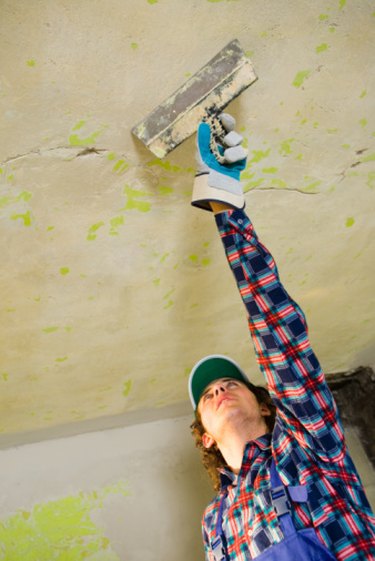
Many homes will develop flaws in their walls or ceilings over time. To evaluate and repair cracks inside your home, determine the material you're working with. Most U.S. homes have ceilings and walls made of drywall, rather than plaster. Plaster is more common in homes built before the 1960s, and it needs a different repair approach than drywall.
Recurring Cracks
Video of the Day
Recurring cracks are plaster fissures that reappear after repair. To spot recurring cracks, look for patching plaster oozing out of a split in your wall or ceiling. Recurring cracks are most likely to show themselves when a home's relative humidity levels rise and the wood frame expands. Expect to find most of your plaster's recurring cracks in a few key areas, including at the corners of doors and windows and in the middle of ceilings and foundation walls.
Video of the Day
Causes
Myriad factors can create recurring wall or ceiling fissures. A home's wood framing expands and contracts with the seasons; that movement can generate cracks that return persistently. A weak foundation or frame can lead to recurring cracks. Returning diagonal cracks over doorways point to foundation settling or vibrations from passing trucks, nearby railroads or earthquakes. Cracks can also redevelop when plaster connections separate from the wooden lathes behind the wall or ceiling. Even soil conditions can affect plaster: Softer dirt prone to shifting can mean more cracks in a home's walls and ceilings.
When to Worry
Not all plaster cracks require the same attention. Hairline cracks less than 1/8 inch wide or less than 18 inches long, also called common cracks, aren't cause for panic, especially if they're old fissures without loose material around them. Still, monitor common cracks for indications that they're worsening. Major cracks are typically more than 1/8 inch wide and more than 18 inches long. Major cracks appear more frequently in the middle of a wall or ceiling, and are often high in number. They're also unusually shaped, appearing as a "V" or in a stair-step pattern. Also note that weather will affect cracks: Plaster fissures will widen in cold, dry conditions and close when it's humid or rainy.
Fixes
Consult a structural engineer if you spot major recurring cracks, because the flaws could indicate problems in your home's foundation. For smaller, common recurring cracks, remove loose plaster around the flaw. If the crack grows after you brush away the loose plaster, consider covering the spot with 3/8-inch drywall screwed through the studs. If the crack doesn't expand, apply fiberglass mesh tape over the fissure. Cover the fix with joint compound. For networks of thin, spidery cracks, buy wallpaper made for restoring wall surfaces.